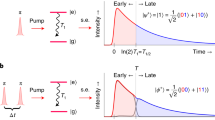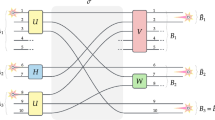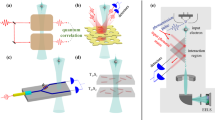Abstract
Bell's theorem1 states that certain statistical correlations predicted by quantum physics for measurements on two-particle systems cannot be understood within a realistic picture based on local properties of each individual particle—even if the two particles are separated by large distances. Einstein, Podolsky and Rosen first recognized2 the fundamental significance of these quantum correlations (termed ‘entanglement’ by Schrödinger3) and the two-particle quantum predictions have found ever-increasing experimental support4. A more striking conflict between quantum mechanical and local realistic predictions (for perfect correlations) has been discovered5,6; but experimental verification has been difficult, as it requires entanglement between at least three particles. Here we report experimental confirmation of this conflict, using our recently developed method7 to observe three-photon entanglement, or ‘Greenberger–Horne–Zeilinger’ (GHZ) states. The results of three specific experiments, involving measurements of polarization correlations between three photons, lead to predictions for a fourth experiment; quantum physical predictions are mutually contradictory with expectations based on local realism. We find the results of the fourth experiment to be in agreement with the quantum prediction and in striking conflict with local realism.
This is a preview of subscription content, access via your institution
Access options
Subscribe to this journal
Receive 51 print issues and online access
$199.00 per year
only $3.90 per issue
Buy this article
- Purchase on Springer Link
- Instant access to full article PDF
Prices may be subject to local taxes which are calculated during checkout




Similar content being viewed by others
References
Bell, J. S. On the Einstein-Podolsky-Rosen paradox. Physics 1, 195–200 (1964); reprinted Bell, J. S. Speakable and Unspeakable in Quantum Mechanics (Cambridge Univ. Press, Cambridge, 1987).
Einstein, A., Podolsky, B. & Rosen, N. Can quantum-mechanical description of physical reality be considered complete? Phys. Rev. 47, 777–780 (1935).
Schrödinger, E. Die gegenwärtige Situation in der Quantenmechanik. Naturwissenschaften 23, 807–812; 823–828; 844–849 (1935).
Aspect, A. Bell's inequality test: more ideal than ever. Nature 390, 189–190 (1999).
Greenberger, D. M., Horne, M. A. & Zeilinger, A. in Bell's Theorem, Quantum Theory, and Conceptions of the Universe (ed. Kafatos, M.) 73–76 (Kluwer Academic, Dordrecht, 1989).
Greenberger, D. M., Horne, M. A., Shimony, A. & Zeilinger, A. Bell's theorem without inequalities. Am. J. Phys. 58, 1131–1143 (1990).
Bouwmeester, D., Pan, J.-W., Daniell, M., Weinfurter, H. & Zeilinger, A. Observation of three-photon Greenberger-Horne-Zeilinger entanglement. Phys. Rev. Lett. 82, 1345–1349 (1999).
Mermin, N. D. What's wrong with these elements of reality? Phys. Today 43, 9–11 (1990).
Bouwmeester, D. et al. Experimental quantum teleportation. Nature 390, 575–579 (1997).
Pan, J.-W., Bouwmeester, D., Weinfurter, H. & Zeilinger, A. Experimental entanglement swapping: Entangling photons that never interacted. Phys. Rev. Lett. 80, 3891–3894 (1998).
Laflamme, R., Knill, E., Zurek, W. H., Catasti, P. & Mariappan, S. V. S. NMR Greenberger-Horne-Zeilinger states. Phil. Trans. R. Soc. Lond. A 356, 1941–1947 (1998).
Ou, Z.Y. & Mandel, L. Violation of Bell's inequality and classical probability in a two-photon correlation experiment. Phys. Rev. Lett. 61, 50–53 (1988).
Shih, Y. H. & Alley, C. O. New type of Einstein-Podolsky-Rosen-Bohm experiment using pairs of light quanta produced by optical parametric down conversion. Phys. Rev. Lett. 61, 2921–2924 (1988).
Kwiat, P., Eberhard, P. E., Steinberger, A. M. & Chiao, R. Y. Proposal for a loophole-free Bell inequality experiment. Phys. Rev. A 49, 3209–3220 (1994).
De Caro, L. & Garuccio, A. Reliability of Bell-inequality measurements using polarization correlations in parametric-down-conversion photons. Phys. Rev. A 50, R2803–R2805 (1994).
Popescu, S., Hardy, L. & Zukowski, M. Revisiting Bell's theorem for a class of down-conversion experiments. Phys. Rev. A 56, R4353–4357 (1997).
Zukowski, M. Violations of local realism in multiphoton interference experiments. Phys. Rev. A 61, 022109 (2000).
Mermin, N. D. Extreme quantum entanglement in a superposition of macroscopically distinct states. Phys. Rev. Lett. 65, 1838–1841 (1990).
Roy, S. M. & Singh, V. Tests of signal locality and Einstein-Bell locality for multiparticle systems. Phys. Rev. Lett. 67, 2761–2764 (1991).
Zukowski, M. & Kaszlikowski, D. Critical visibility for N-particle Greenberger-Horne-Zeilinger correlations to violate local realism. Phys. Rev. A 56, R1682–1685 (1997).
Pearle, P. Hidden-variable example based upon data rejection. Phys. Rev. D 2, 1418–1425 (1970).
Clauser, J. & Shimony, A. Bell's theorem: experimental tests and implications. Rep. Prog. Phys. 41, 1881–1927 (1978).
Weihs, G., Jennewein, T., Simon, C., Weinfurter, H. & Zeilinger, A. Violation of Bell's inequality under strict Einstein locality conditions. Phys. Rev. Lett. 81, 5039–5043 (1998).
Bose, S., Vedral, V. & Knight, P. L. Multiparticle generalization of entanglement swapping. Phys. Rev. A 57, 822–829 (1998).
Haroche, S. Atoms and photons in high-Q cavities: next tests of quantum theory. Ann. NY Acad. Sci. 755, 73–86, (1995).
Briegel, H.-J., Duer, W., Cirac, J. I. & Zoller, P. Quantum repeaters: The role of imperfect local operations in quantum communication. Phys. Rev. Lett. 81, 5932–5935 (1998).
Cleve, R. & Buhrman, H. Substituting quantum entanglement for communication. Phys. Rev. A 56, 1201–1204 (1997).
Kwiat, P. G. et al. New high intensity source of polarization-entangled photon pairs. Phys. Rev. Lett. 75, 4337–4341 (1995).
Zeilinger, A., Horne, M. A., Weinfurter, H. & Zukowski, M. Three particle entanglements from two entangled pairs. Phys. Rev. Lett. 78, 3031–3034 (1997).
Zukowski, M., Zeilinger, A. & Weinfurter, H. Entangling photons radiated by independent pulsed source. Ann. NY Acad. Sci. 755, 91–102 (1995).
Acknowledgements
We thank D. M. Greenberger, M. A. Horne and M. Zukowski for useful discussions. This work was supported by the Austrian Fonds zur Förderung der Wissenschaftlichen Forschung, the Austrian Academy of Sciences and the Training and Mobility of Researchers programme of the European Union.
Author information
Authors and Affiliations
Corresponding author
Rights and permissions
About this article
Cite this article
Pan, JW., Bouwmeester, D., Daniell, M. et al. Experimental test of quantum nonlocality in three-photon Greenberger–Horne–Zeilinger entanglement. Nature 403, 515–519 (2000). https://doi.org/10.1038/35000514
Issue Date:
DOI: https://doi.org/10.1038/35000514
This article is cited by
-
Efficient generation of Greenberger–Horne–Zeilinger states of N driven qubits mediated by a cavity
Quantum Information Processing (2023)
-
Semi- quantum Designated Verifier Signature Scheme
International Journal of Theoretical Physics (2023)
-
Microtubules as a potential platform for energy transfer in biological systems: a target for implementing individualized, dynamic variability patterns to improve organ function
Molecular and Cellular Biochemistry (2023)
-
Influence of the Stark Shift and Field Nonclassicality on the Dynamics of Non-classical Correlations of N two-level Atomic System
International Journal of Theoretical Physics (2023)
-
Recent advances in room temperature single-photon emitters
Quantum Information Processing (2023)
Comments
By submitting a comment you agree to abide by our Terms and Community Guidelines. If you find something abusive or that does not comply with our terms or guidelines please flag it as inappropriate.



